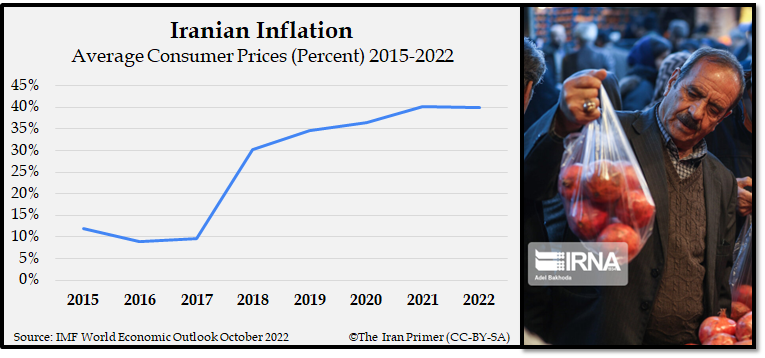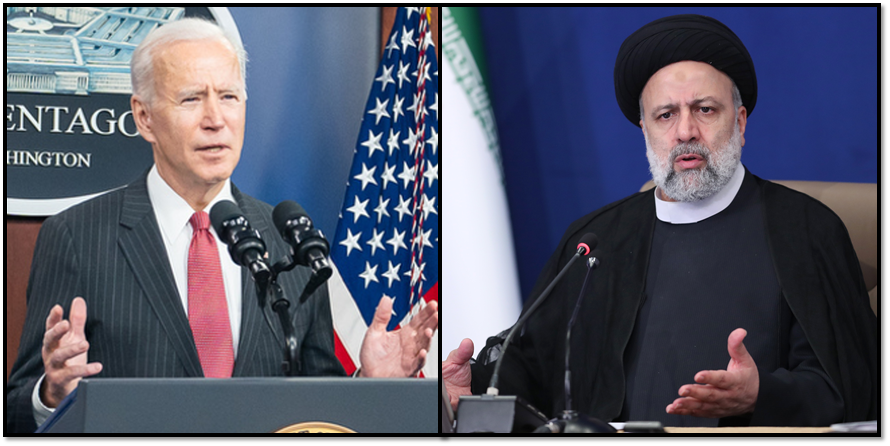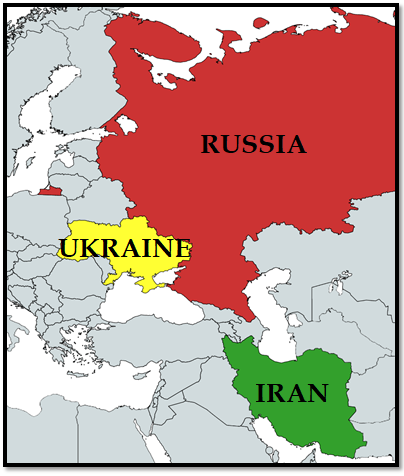Iran marks the anniversary of the Islamic revolution in February amid increasingly existential challenges at home and in relations with the outside world. Four months of nationwide protests — triggered by the death of 22-year-old Mahsa Amini in September 2022 — reflected deepening discontent among Iran’s Gen Z. Young women on streets and at schools abandoned the headscarves required by law, as shouts of “woman, life, freedom” and “death to the dictator” echoed across campus grounds. The protests were a brazen rejection of Supreme Leader Ayatollah Ali Khamenei and, more broadly, the theocracy’s basic belief that god’s law supersedes human laws. The scope of fury was reflected on October 8, when female students at Al Zahra University in Tehran shouted “Clerics, get lost” during a visit by President Ebrahim Raisi.
Despite debate within the ruling circle, the government balked at embracing any compromises to address demands by the young for greater personal freedoms, opting instead to use force to put down the demonstrations. Hundreds died. Thousands were arrested on vague charges, including “enmity toward God” and “corruption on earth.” After sham trials — some reportedly lasting only 15 minutes — the judiciary handed down long prison and death sentences, in turn triggering outrage abroad. After the execution of café worker Mohsen Shekari on December 8, Secretary of State Antony Blinken said the United States was “appalled” by Iran’s callousness. “Our message to Iran’s leadership is clear: End this brutal crackdown. We will continue to hold the Iranian regime accountable,” he tweeted.
A Pattern of Protests and a Troubled Economy
The pace and scope of protests waned in early 2023. Yet the core discontent still burned deeply. Iran has faced a growing cycle of protests, beginning with the Green Movement in 2009, when millions marched through streets in cities nationwide for almost six months to challenge the results of a presidential election. It, too, petered out under the weight of draconian security tactics. Protests erupted again in 2017, initially over the price of poultry and eggs, but quickly grew into anger over the failures of the Islamic republic. In 2019, demonstrations were ignited by a sudden hike in the price of fuel. So, by 2023, the scope of incendiary flashpoints — political, economic and cultural — and the range of society impacted had steadily grown. So had the regime’s vulnerability.
The government has failed on other fronts too. In Raisi’s first full year in office, Iran’s economy tanked in most key indicators. The value of the rial hit an unprecedented 400,000 to the dollar — up from just 70 rials to the dollar when the revolution ousted the monarchy four decades ago. Inflation soared too. In November 2022, the government admitted that consumer prices had increased a staggering 48 percent in just a year, while the average prices of food and beverages surged by 68 percent. For millions of Iranians, daily survival became a growing problem.

For almost one of every 10 Iranians, finding a job to pay the escalating prices has been a persistent problem. Official unemployment in 2022 was almost nine percent, while unemployment among the unhappy younger generation exceeded 16 percent. The economy contracted in key areas — including agriculture and construction — needed to feed and house Iran’s burgeoning population of 85 million people (up from 37 million during the revolution). Iran’s so-called “resistance economy” managed to endure despite U.S. sanctions, mainly by selling about 1 million barrels of oil a day. China was the main importer. Yet Iran lost $450 billion in oil revenues over a decade because of U.S. and other international sanctions, Aftab news, an Iranian news website, estimated in November 2022.
Tensions with the West
Iran’s escalating domestic woes overlapped with escalating tensions with the West. In August 2022, diplomacy between Iran and the world’s six major powers — Britain, China, France, Germany, Russia and the United States — deadlocked on terms to revive the historic 2015 nuclear deal. President Trump had withdrawn the United States from the deal in 2018 and reimposed U.S. sanctions. His “maximum pressure” campaign was designed to force Iran into more concessions. Tehran, instead, began to breach its obligations under the deal to get Washington to lift sanctions. The threat from a potential Iranian nuclear program only grew. President Biden vowed to return to the deal.

Under European Union auspices, diplomacy to get both the United States and Iran to honor the deal was launched in Vienna in April 2021. Negotiations got tougher after Iran elected the hardline Raisi to replace Hassan Rouhani, the centrist who had dared to take a telephone call from President Barack Obama and then entered into high-level diplomacy for the first time since the revolution. The six major powers expected agreement on an EU proposal in August 2022, but Iran balked — and then accelerated advances in its nuclear program.
By early 2023, outgoing Israeli Defense Forces chief Lt. Gen. Aviv Kochavi estimated that the Islamic republic had enriched enough uranium to fuel four nuclear weapons — three with uranium enriched to 20 percent and one with uranium enriched to 60 percent. (The usual level of enrichment is 90 percent.) Other steps are required to actually produce a viable bomb, including making a warhead, marrying it to the explosive and developing a delivery system. Tehran has still not made the political decision to cross the threshold, U.S. intelligence has repeatedly claimed. Experts estimate it would need anywhere from several months to up to two years to produce a bomb. But Iran is already the only country in the world without a nuclear weapon that has ballistic missiles that can reach 2,000 kilometers.
In a briefing on January 9, State Department spokesman Ned Price charged that Iran had “killed” the prospect of a swift return to compliance with the nuclear deal, formerly known as the Joint Comprehensive Plan of Action, or JCPOA. “That’s because the Iranians turned their back on it, the Iranians reneged on commitments they had made,” Price said. The international furor over Iran’s treatment of protesters further complicated any imminent return to diplomacy, which was untenable for Western powers.
 The regime’s support for Russia in the Ukraine war has deepened the chasm with the West, especially the United States. In July 2022, National Security Advisor Jake Sullivan revealed that Iran had agreed to provide Russia President Vladimir Putin with drones capable of suicide bombings, airstrikes and reconnaissance missions. The Russian military began deploying the Shahed 131 and 136 and the Mohajer 2 and 6 in September. Teams of Iranian Revolutionary Guards (IRGC) deployed in Crimea to train their Russian counterparts, U.S. officials said.
The regime’s support for Russia in the Ukraine war has deepened the chasm with the West, especially the United States. In July 2022, National Security Advisor Jake Sullivan revealed that Iran had agreed to provide Russia President Vladimir Putin with drones capable of suicide bombings, airstrikes and reconnaissance missions. The Russian military began deploying the Shahed 131 and 136 and the Mohajer 2 and 6 in September. Teams of Iranian Revolutionary Guards (IRGC) deployed in Crimea to train their Russian counterparts, U.S. officials said.
By early 2023, dozens of Iranian drones had attacked Ukrainian military installations as well as infrastructure, businesses and civilians. Washington warned that Iran was also considering supplies of ballistic missiles to Russia. “Russia is seeking to collaborate with Iran on areas like weapons development and trade,” John Kirby, the National Security Council strategic communications coordinator, said in December. Iran had become Russia’s “top military backer.” In turn, Moscow was also helping Tehran deal with its protests and was considering selling warplanes. Relations between the two are deeper than any time in at least a century.
Longstanding U.S. criticism deepened amid claims that Iran was actively plotting against President Trump and other former American officials involved in the assassination of Maj. Gen. Qassem Soleimani, commander of the IRGC Quds Force, in early 2020. On January 18, State Department spokesman Ned Price said, “There is no more nefarious exporter of international terrorism than Iran.” Countries around the world “have seen all too vivid demonstrations of the lethality of the IRGC, of its repugnant willingness to take innocent lives in its operations,” he said. The United States was “clear-eyed” about cooperating with allies on threats posed by the Revolutionary Guards.
A Vulnerable Regime
For all Iran’s tough defiance and menacing policies, the regime seems more brittle than at any time since the revolution — especially as a leadership transition looms. Khamenei, who has been in power since 1989, turns 84 in July. He was crippled after a tape recorder bomb went off in 1981 and lost the use of his right arm. He was diagnosed with prostate cancer in 2014. In late 2022, Western officials claimed he was again in poor health, although he made several public appearances even as protests raged.
Khamenei has not publicly named a favorite candidate to succeed him. Iran’s constitution designates the Assembly of Experts, an elected body of 86 senior Islamic jurists and clerics, to pick the supreme leader. There is only one precedent. In 1989, when Khamenei was president, revolutionary leader Ayatollah Ruhollah Khomeini died after having a heart attack. In 2023, hardliners or Principlists — so called because of their commitment to rigid revolutionary doctrine — have the distinct edge. They control all major branches of executive, legislative and judicial power as well as the military and several major economic sectors. As the Iran revolution marks its 44th anniversary, the prospect of domestic reforms, nuclear diplomacy or better relations with the West appear, at best, quite remote. The dangers of confrontation with its own population as well as much of the outside world appeared unprecedented.
Robin Wright, a foreign policy analyst, author and journalist, is a joint fellow at the U.S. Institute of Peace and the Woodrow Wilson International Center.
This article originally appeared on USIP.org.
